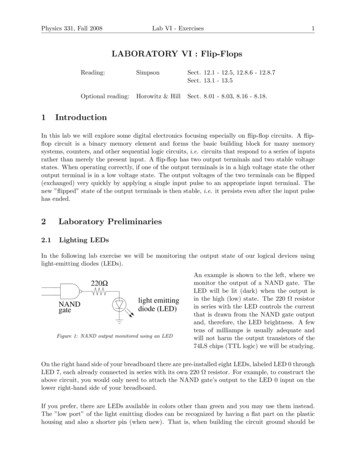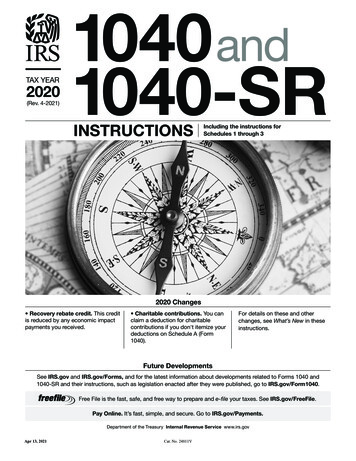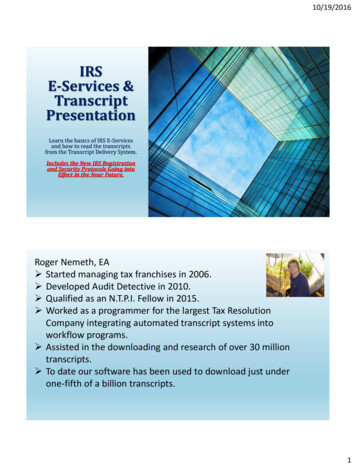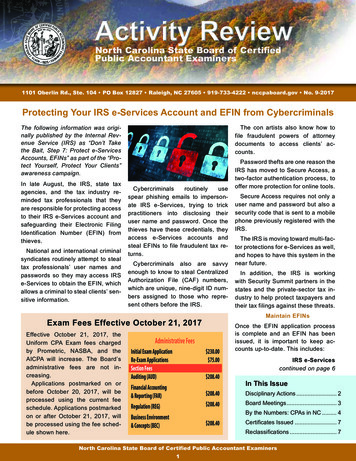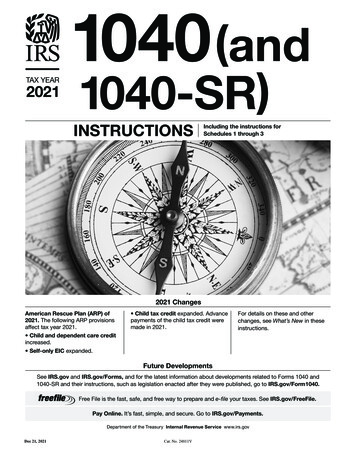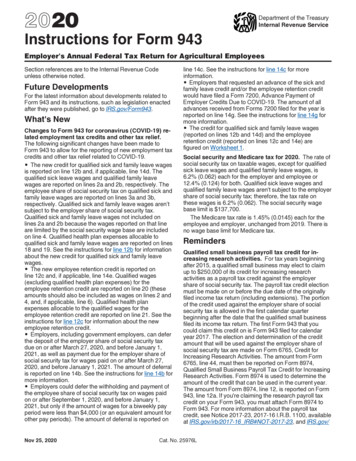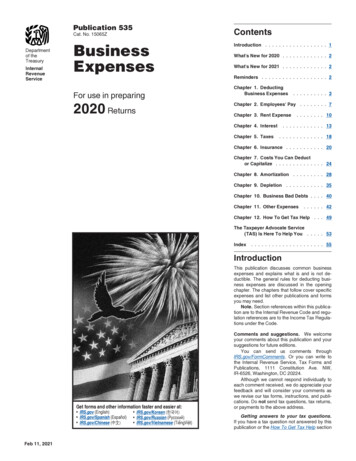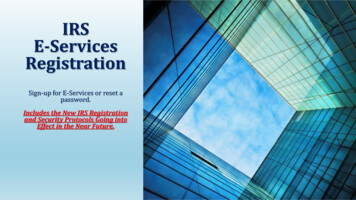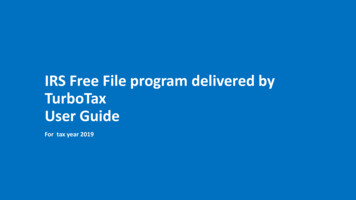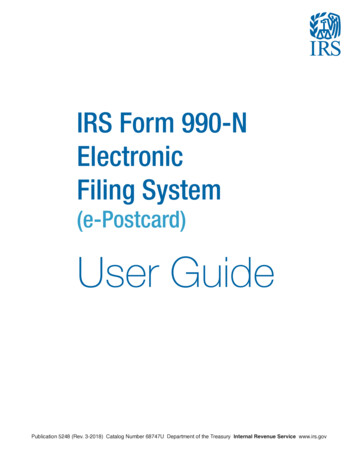
Transcription
Final IRS Sect. 67(e) Regs for Estate and Trust Taxpayers:Applying the Required 2% Deduction FloorWEDNESDAY, OCTOBER 15, 2014, 1:00-2:50 pm EasternIMPORTANT INFORMATIONThis program is approved for 2 CPE credit hours. To earn credit you must: Participate in the program on your own computer connection and phone line (no sharing) – if you need to registeradditional people, please call customer service at 1-800-926-7926 x10 (or 404-881-1141 x10). Strafford accepts AmericanExpress, Visa, MasterCard, Discover. Respond to verification codes presented throughout the seminar. If you have not printed out the “Official Record ofAttendance”, please print it now. (see “Handouts” tab in “Conference Materials” box on left-hand side of your computerscreen). To earn Continuing Education credits, you must write down the verification codes in the corresponding spaces foundon the Official Record of Attendance form. Complete and submit the “Official Record of Attendance for Continuing Education Credits,” which is available on theprogram page along with the presentation materials. Instructions on how to return it are included on the form. To earn full credit, you must remain on the line for the entire program.WHOM TO CONTACTFor Additional Registrations:-Call Strafford Customer Service 1-800-926-7926 x10 (or 404-881-1141 x10)For Assistance During the Program:- On the web, use the chat box at the bottom left of the screen- On the phone, press *0 (“star” zero)If you get disconnected during the program, you can simply call or log in using your original instructions and PIN.
FOR LIVE EVENT ONLYSound QualityIf you are listening via your computer speakers, please note that the qualityof your sound will vary depending on the speed and quality of your internetconnection.If the sound quality is not satisfactory, you may listen via the phone: dial1-866-320-7825 and enter your PIN when prompted. Otherwise, pleasesend us a chat or e-mail sound@straffordpub.com immediately so we can addressthe problem.If you dialed in and have any difficulties during the call, press *0 for assistance.Viewing QualityTo maximize your screen, press the F11 key on your keyboard. To exit full screen,press the F11 key again.
FOR LIVE EVENT ONLYIf you have not printed the conference materials for this program, pleasecomplete the following steps: Click on the symbol next to “Conference Materials” in the middle of the lefthand column on your screen. Click on the tab labeled “Handouts” that appears, and there you will see aPDF of the slides and the Official Record of Attendance for today's program. Double-click on the PDF and a separate page will open. Print the slides by clicking on the printer icon.
Final IRS Sect. 67(e) Regs for Estateand Trust TaxpayersOct. 15, 2014Tina D. MilliganDomingo P. Such, IIIHarrismyCFOPerkins .com
NoticeANY TAX ADVICE IN THIS COMMUNICATION IS NOT INTENDED OR WRITTEN BYTHE SPEAKERS’ FIRMS TO BE USED, AND CANNOT BE USED, BY A CLIENT OR ANYOTHER PERSON OR ENTITY FOR THE PURPOSE OF (i) AVOIDING PENALTIES THATMAY BE IMPOSED ON ANY TAXPAYER OR (ii) PROMOTING, MARKETING ORRECOMMENDING TO ANOTHER PARTY ANY MATTERS ADDRESSED HEREIN.You (and your employees, representatives, or agents) may disclose to any and all persons,without limitation, the tax treatment or tax structure, or both, of any transactiondescribed in the associated materials we provide to you, including, but not limited to,any tax opinions, memoranda, or other tax analyses contained in those materials.The information contained herein is of a general nature and based on authorities that aresubject to change. Applicability of the information to specific situations should bedetermined through consultation with your tax adviser.5
Final IRS Sect. 67(e) Regs for Estate andTrust Taxpayers: Applying the Required 2%Deduction FloorDomingo P. Such III, PartnerPerkins Coie, ChicagoTina D. Milligan, Managing DirectorCTC myCFOOctober 15, 2014
AGENDA7
Agenda Background: Court cases and Regulations prior to finalized I.R.C. Section67(e) Regulations Details on final Regulations Practical examples and strategies8
BACKGROUND9
Evolution of the deductibility of investment advisoryexpenses Section 23(a) of the Internal Revenue Code Act of 1928–Predecessor to I.R.C. Section 162 – Trade or business expenses–Allowed deductions for both taxpayer’s trade or business and other profit-oriented expenses Higgins v. Commissioner, 312 U.S. 212 (1941)–Ruled in favor of the IRS–Taxpayer not entitled to deduction for expenses incurred in a profit-oriented activity unless partof a trade or business–IRS revoked all prior guidance and authority permitting deduction for non-business, profitoriented expenses Section 23(a)(2) of the Internal Revenue Code (1942)–predecessor to I.R.C. Section 212 – Expenses for production of income10
Overview of I.R.C. Section 212 I.R.C. Section 212–Deduction for all ordinary and necessary expenses paid or incurred during the taxable year: For the production or collection of income; For the management, conservation, or maintenance of property held for the production ofincome; or In connection with the determination, collection or refund of any tax–Deductions are not included on the I.R.C. Section 67(b) list of non-miscellaneous deductions–Generally permits deductions for expenses, such as fiduciary fees, incurred in connection withthe administration of an estate or trust.–Classifies trust or estate administration expenses, if not allowed in computing AGI under I.R.C.Sections 62(a) or 67(c), as miscellaneous itemized deductions subject to the 2% of AGI floor11
Overview of I.R.C. Section 67 Section 67(a)–Taxpayer’s “miscellaneous itemized deductions” may be deducted only to the extent suchexpenses exceed 2% of the taxpayer’s AGI–“2% floor”–Trusts and estate are subject to the same limitation Section 67(b) defines “miscellaneous itemized deductions” as:–Not described in one of twelve categories of deductions listed in I.R.C. Subsections 67(b)(1)(12)–A deduction not allowed in computing AGI, other than a personal exemption–Interest expenses under I.R.C. Section 163 are not miscellaneous itemized deductions–Certain taxes under I.R.C. Section164 are not miscellaneous itemized deductions12
Overview of I.R.C. Section 67 Section 67(e) will not apply to expenses paid or incurred in connection withadministration of an estate or trust if would not have been incurred if theproperty were not held in such estate or trust.13
Slide Intentionally Left Blank
Overview of I.R.C. Section 68 Section 68–Reduces a taxpayer’s itemized deductions by an amount equal to the lesser of : 3% multiplied by the excess of AGI over the applicable amount, or 80% of the total itemized deduction otherwise allowable for such taxable year15
Overview of I.R.C. Section 56 Section 56–No deduction is allowed for Section 212 expenses for purposes of AMT–Any amount deducted from AGI for miscellaneous itemized deductions will be “added back”into taxpayer’s AGI to compute AMT16
Definition of AGI for a trust Section 67(e) definition of AGI for a trustGross income: All income from whatever source derivedLess: Deductions Deductions taken directly against gross income - “above the line”– Deductions that would be allowed in computing an individual’s AGI under section62(a),» such as deductions attributable to a trade or business, or» to property held in the production of rents or royalties;– Deductions for distributions to beneficiaries under sections I.R.C. Sections 651 or661;– Personal exemptions under I.R.C. 642(b); and– Deductions “for costs which are paid or incurred in connection with theadministration of an estate or trust and which would not have been incurred if theproperty were not held in such trust or estate.” Adjusted Gross Income 17
Taxable income Tax is imposed on “taxable income” of both individuals and trusts1Gross income: All income from whatever source derivedLess: Deductions Deductions taken directly against gross income - “above the line” Adjusted Gross Income Deductions taken from AGI - “below the line” (i.e. Investment advisory fees) Taxable Income18
Court cases Split between Sixth Circuit and Fourth/Federal Circuit rulings Knight v. Commissioner U.S. Supreme Court Decision–Knight V. Commissioner, 522 U.S. 181 (2008)–Criticized the Treasury’s interpretation of exception in Proposed Regulations–Proposed Regulations limit the Section 67(e) exception to costs which were “unique” to a trustor estate costs that could not be incurred by an individual–The court held Treasury’s interpretation too narrow Trust and estate expenses should not be subject to the 2% floor– if not “customarily or commonly incurred” by an individual Even investment advisory fees could fall within the category of expenses not “customarilyor commonly” incurred by individuals19
Treasury guidance and Proposed Regulations Temporary guidance leading up to final Regulations–Treasury responded to the Knight decision–Notice 2008-32–Proposed Regulations in 2011 Left lack of clarity–Confusion over investment advisory fees20
Slide Intentionally Left Blank
FINAL REGULATIONS22
The final 67(e) regulations 2% floor applies if they are costs “commonly or customarily” incurred by ahypothetical individual holding the same property23
The final 67(e) regulations Fiduciary expenses that will be subject to the 2% floor–Ownership costs–Tax preparation fees other than those incurred for: estate tax returns Generation skipping transfer tax returns Fiduciary income tax returns Decedents’ final income tax returns–Investment advisory fees (subject to a limited exception)–Appraisal fees, except those required: in preparation of the trust’s transfer tax returns, or income tax returns, or needed to measure distributions (i.e. annual unitrust amount)24
The final 67(e) regulations Fiduciary expenses that will not be subject to the 2% floor–Not “commonly or customarily” incurred by individuals Probate court fees Fiduciary bond premiums Fees for publishing notices legally required in the administration of a decedent’s estate Costs of certified copies of a death certificate Costs of preparing fiduciary accountings25
The final 67(e) regulations Investment advisory fees – not “commonly or customarily” incurred byindividuals–Additional charges for the implementation of an unusual investment objective: required by the terms of the estate or trust, or resulting from the need to balance interests of the beneficiaries–Incremental cost of these services should not be subject to the 2% floor–Final Regulations state that this portion of investment advisory fees is limited to the amount inexcess of those normally charged to individual investors26
The final 67(e) regulations Bundled fees–Fiduciaries charging a single fee for mixed services where a portion would be exempt from 2%floor must “unbundle” fees–Reasonable method for allocation Allocate and separately state the portion subject to 2% floor versus exempt If not calculated on an hourly basis: only the portion reasonably allocated to investmentadvice must be subjected to 2% floor Only general guidance on reasonable method27
The final 67(e) regulations Effective date–Existing estates with fiscal years ending December through April, calendar year No earlier than January 1, 2015–Estates of decedents dying on or after May 9, 2014 May 9, 2014–Trusts created on or after May 9, 2014 May 9, 2014–Trusts with fiscal year end during months of May through November May 9, 2014 (accelerated)28
Slide Intentionally Left Blank
PRACTICAL EXAMPLES ANDSTRATEGIES30
Methods for allocating fees “Any reasonable method” Possible to support method with best result in smallest allocation to investmentmanagement, so long as reasonable method Consistency not required for a fiduciary of multiple trusts and estates–Depending on facts and circumstances: one reasonable method for one trust and anotherreasonable method for a different trust Final regulations appear to permit the use of multiple factors in allocating fees31
Methods for allocating fees Time spent on investment management duties and assets under investmentmanagement–Example: fiduciary determines time spent on investment management based on percent of trustassets requiring investment management - remainder not subject to 2% limitationInvestment ManagementActivitiesTotal Fiduciary Fee 100,000Subject to 2% AGI limitationPercent of trust assets under investment management50%Percent of time on investment management50%Total percent of feeFee allocation32All Other Fiduciary DutiesNot subject to 2% AGIlimitation(50% x 50%) 25%75% remaining 25,000 75,000
Methods for allocating fees Trust instrument requires asset be retained–Closely held business–Home for beneficiary(ies)–Insurance Investment policy of trust counter to prudent investor standards Number, percent and types of professionals–Relationship management–Investment advisors–Investment committee–Trust administrators–Legal professionals Track time on investment versus fiduciary activities33
Methods for allocating fees Comparison to other fees: fiduciary insurance or investment fee only (withoutfiduciary service)Total Fiduciary FeeInsurance Fee 150,000Total Fiduciary FeeDifference Investment Fee 100,000Investment Manager Fee – 80 bps 150,000 50,000Difference Fiduciary Fee 80,000 Comparison of fees paid to fiduciary with no special investment skill Comparison of fees paid to directed trustee34 70,000
Comparison of “above the line” and “below the line” 100,000 Fiduciary Fee“Below the line”deductionGross incomeAbove the line deductionAdjusted Gross Income“Above the line” deductions 1,000,000 1,000,000 iscellaneous itemizeddeduction100,00050,00025,0002% floor(20,000)(19,000)(18,500)Allowable miscellaneousitemized deductionTaxable income(80,000)(31,000)(6,500) 920,000 919,000 918,50035
Impact of I.R.C. 67 as AGI increaseAGI 1 millionInvestment incomeAGI 10 millionAGI 20 million 1,000,000 10,000,000 20,000,0001,000,00010,000,00020,000,000Investment managementfees500,000500,000500,0002% Floor(20,000)(200,000)(400,000)Miscellaneous t on itemized deductions(20,849)(240,000)(80,000)Total itemized deductions459,15160,00020,000Percent of deduction lost4%88%96%AGIPercent of deduction lost36
Impact of I.R.C. 67 as AGI increaseAdjusted Gross Income37
Impact of I.R.C. 67 as 212 expenses increaseAGI 10 million all casesInvestment income 400,000 subject 2% 600,000 subject 2% 800,000 subject 2% 10,000,000 10,000,000 00600,00050%33%25%(160,000)(290,849)(290,849)Total itemized deductions40,000109,151309,151Percent of deduction lost90%81%61%AGIInvestment managementfees2% FloorMiscellaneous itemizeddeductionPercent of deduction lostLimit on itemized deductions38
Planning considerations Consider AGI implications Consider planning around I.R.C. Section 212 classification Consider reasonable method for allocation of fees39
DisclosureCTC myCFO is a brand delivering services through CTC myCFO, LLC an investment adviser registered with the Securities and Exchange Commission and a Commodity PoolOperator registered with the National Futures Association; certain divisions of BMO Harris Bank N. A., a national bank with trust powers; and BMO Delaware Trust Company, aDelaware limited purpose trust company. Not all products and services are available in every state and/or location.Investment products offered: ARE NOT A DEPOSIT – NOT INSURED BY THE FDIC OR ANY FEDERAL GOVERNMENT AGENCY – NOT GUARANTEED BY ANY BANK – MAYLOSE VALUE. CTC myCFO also offers Family Office Services, including tax consulting services, through CTC myCFO, LLC. Family Office Services are not fiduciary services andare not subject to the Investment Advisers Act of 1940 or the rules promulgated thereunder.Capital Advisory Services is part of CTC myCFO, a brand for various companies of BMO Financial Group. Capital Advisory Services are only offered by a division of BMO HarrisBank N.A. in its Chicago, IL and Milwaukee, WI locations. Banking deposit and loan products and services are provided by BMO Harris Bank N.A. and are subject to bank and creditapproval. BMO Harris Bank N.A. Member FDIC.NMLS #401052CTC myCFO and its affiliates do not provide legal advice to clients. You should review your particular circumstances with your independent legal advisor.As of June 30, 2014, CTC myCFO had approximately 41 billion in assets under management or advisement, including 20 billion in discretionary assets under management and 21 billion in nondiscretionary consulting asset under advisement, and approximately 43 billion in assets under administration and custody.The PAM Awards are awarded annually by Private Asset Management, a financial services industry trade publication. The PAM Awards invites firms to compete for awards in severalcategories by providing answers regarding their business model, services offered, growth in client count and assets managed countries of operation, service innovation, andperformance. In addition, The PAM Awards permits firms to provide additional information of their choosing in support of their candidacy. A panel of independent industry expertsselects the nominees and winners based on a number of qualitative and quantitative performance indicators. The PAM Awards do not release statistics on the number of firmscompeting. Nomination or receipt of a PAM Award is not necessarily indicative of any particular client's experience or a guarantee that the firm will perform in the future as it did duringthe period evaluated by The PAM Awards. "RIA Giants", Forbes, 1/13/11 was based on information, as of September 30, 2012, collected by RIA Database. The rules for ranking ofthe Top 50 investment advisors and investment advisories: (1) all firms are registered investment advisors ranked based on discretionary assets under management as defined by theSecurities and Exchange Commission as of Sept. 30, 2010; (2) greater than 50% of their business must serve the retail marketplace; (3) advisors must provide financial planningservices or portfolio management for individuals or conduct due diligence on third-party advisors; (4) they must not be doing business as a broker/dealer, bank or insurance company;(5) they can neither charge commissions nor have registered representative employees at the firm; and (6) a majority of the RIA’s business must not be invested in proprietaryproducts.This information is not intended to be tax or legal advice. This information cannot be used by any taxpayer for the purpose of avoiding tax penalties that may be imposed on thetaxpayer. This information is being used to support the promotion or marketing of the planning strategies discussed herein. CTC myCFO and its affiliates do not provide legal adviceto clients. You should review your particular circumstances with your independent legal and tax advisors.40
Oct 15, 2014 · Definition of AGI for a trust Section 67(e) definition of AGI for a trust Gross income: All income from whatever source derived Less: Deductions Deductions taken directly against gross income - “above the line” – Deductions that would be allowed in computing
